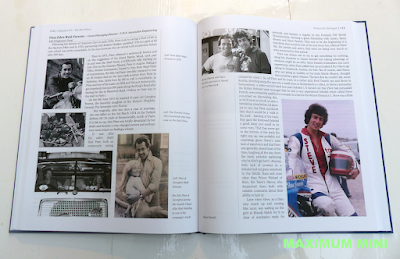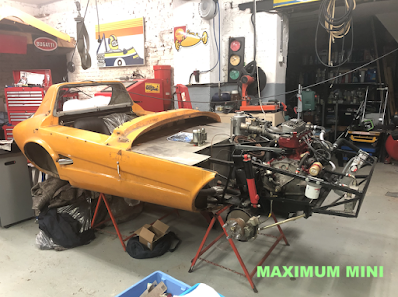Wednesday, 22 December 2021
Happy Christmas 2021
Monday, 20 December 2021
Boxing Day 1967 - with Best Wishes from Checkers
A copy of this leaflet, which I'd never seen before, was sent to me by Joost van Diën. Yes, that's the 1967 Le Mans Mini Marcos works car with its modified windscreen. It's seen here during its time with South-African racer Peter Kat, who was sponsored by Checkers - a South-African supermarket chain. Kat's first race in the Marcos took place at the Roy Hesketh circuit on Boxing Day, December 26th, in 1967. Checkers certainly seem to have had good faith in him. Kat and his c-driver Dirk Marais came 11th overall.
Last year in July I incidentally caused a bit of a stir when I wrote about this (originally green) car and its (originally yellow) sister car, mixing them up. There was a good excuse though. It turned out that the yellow Mini Marcos had received a signature modification also: its windscreen was modified just like the one on the green car, somewhere between 19 June and 23 July 1967. A comprehensive new article with many pictures followed, which you can still read here. Meanwhile a few more pictures of the car during its Checkers sponsorship have turned up, one of them showing it in its colours (here). Keep them coming!
Friday, 17 December 2021
Le Mans Mini Marcos: Update from Pau (2)
In the world car manufacture a marriage takes place when body and drivetrain are joined and I am happy to announce that today this event will take place for the one and only 1966 Le Mans Mini Marcos in the workshop of Mini World Center in Pau. It's just a pity I can't be there and naturally there are a few complications, but I'm sure we will overcome. More to follow soon!
Wednesday, 15 December 2021
Le Mans Mini Marcos: Update from Pau (1)
I am very glad to write to you that work is progressing on the Mini Marcos' mechanicals over at Philippe Quirière's Mini World Center in Pau, France. These pictures came just in and show a bit more of what happened in the last couple of days. Car and engine will soon be joined together after all those years again. I can't wait.
Tuesday, 14 December 2021
Find of the Year 2021: the candidates
Well-well, 2021 was a remarkable year when it came to long-lost Mini based cars. With 24 exciting discoveries in sheds, barns, gardens and woods the number of Mini derivatives being rediscovered keeps on growing. It's not easy to make a top-5 with so many exiting finds. From Broadspeed GT to Magnum Spectre, and from pairs of Ranger Cubs, ABC Tricars as well as Scamp six-wheelers to the unique AC Donington.
Like last year, I found a few cars myself with Belgium proving to be excellent finding ground: there was the 1967 Cox GTM in a garage in Belgium, the sole GTM 'Euro' Coupe in a Belgian lock-up and the Ogle SX1000 which was originally sold to Belgium and had always remained there. But there was also the Guinness World Record 'blind drive' RTV in bramble bushes in England and the Dutch Barclay Mini Bug.
Now, to vote simply drop a message below or send me an e-mail if you like. The one with the most votes wins the title 'Maximum Mini Find of the Year 2021'. Over to the 5 candidates.
The Deep Sanderson 301 in Mexico. This was one find I could hardly believe myself - a Deep Sanderson 301 road car in a very original state resurfaced in Mexico-City in March. (full story here)
Monday, 13 December 2021
Another book: Richard Oakes - Master of Design
If there is one kit car designer that deserves a book of his own, it's Richard Oakes. Not even Barry Stimson can match him in sheer numbers of designs. Between the early 1970s and today Oakes designed a great number of specialist- and kit cars, from the Dutton Sierra to the Deltayn Pegasus and from Tramp buggy to Nova sports car.
And he was responsible for several Mini based cars, too. There were of course the original Midas and its later incarnations to start with as well as the Midas Gold. But also the Indespension Jiffy, the GTM Coupe plus GTM Rossa, GTM Libra and GTM Spyder, the Domino Pimlico and its variations plus the stillborn ANT III city car (which I didn't even know about).
This book is about all of them and the author Douglas Anderson, interviewed Oakes several times and even did so to his late parents. He was also given full permission to Oakes' archives, which shows. The 176-page book is full of sketches and drawings, all reproduced superbly. The texts with these illustrations are somewhat limited sometimes, but they do match the layout particularly well. I'm sure Oakes himself will agree that it looks good.
The book's last chapter is dedicated to the latest project: the Sprite/Midget based ADO, which is being brought to life by the author himself after another Oakes design. The number of pages this ADO project receives is perhaps relatively many compared to the other vehicles described, but it may say something about the enthusiasm of the author also, whom we can only encourage in this project. Order it directly from him for £30 plus p&p via andersonandclarkpublishing@gmail.com
Friday, 10 December 2021
Enzo Ferrari's Mini - another picture

Thursday, 9 December 2021
Unipower GT book is finally here
Ah, the mighty Unipower GT! So many of us are attracted to the model and so it is great that this particular Mini derivative has finally received a tome of its own describing its creation and development. The car's history is definitely worth telling as its wasn't a particularly straightforward one with ups and downs along the way, a change of ownership half-way through its production life span and some interesting racing history too.
The book's author is Gerry Hulford, a man who knows the marque. Hulford is a Unipower owner since 1971 and owned several GTs since. He knows many of the car's owners too and runs the Unipower GT Owners Club & Register. He has been thinking about writing a book for years - and here it is in 172 pages and illustrated with many photographs. "In 1976", he writes in the preface "I was fortunate enough to purchase all the surviving factory paperwork, drawings, parts lists, documentation and production records." So the book promises a real must-have for us aficionados.
And it does share some in-depth information. And while there are lots of pictures, too, I was disappointed though by the small number of previously unseen ones, which might be expected from the preface. Most of them are well-known with better quality ones available and I also recognized several of my sourced from this very website! And there's something else. I am not a great adept of chassis number listing, which Bugatti and Ferrari owners can't seem to live without these days. Well, chassis numerology seems to have penetrated deeply into this book with Hulford using these numbers throughout. That doesn't make this an easy read, you really need to concentrate.
The inclusion of a production register in the back of the book is welcome and fascinating, though, listing all cars produced by chassis number. Some years ago I sorted my own Unipower GT files and had to decide that the car's chassis numbers were the way to go. Perhaps the devil is in the detail by my own list doesn't always match this one. This may say something about my own numerology, but I'm not sure!
So, yes, this is a book which tells you an awful lot about the great Unipower GT and it will get you through the Christmas days but don't expect a light-hearted read. It's available from the club website here at 39.95 GBP plus p&p (and import fees when you live outside the UK like me).

Monday, 6 December 2021
Meet the 1963 MiniSprint
Friday, 3 December 2021
Peel Viking's original owner gets in touch

Tuesday, 30 November 2021
Le Mans Mini Marcos: the build begins
Boy, has it been a long time since I wrote an update on the Le Mans Mini Marcos project. I could tell you all about the reasons for the delay but let's not worry about that here. Fact is that more happened in the last week then in the 18 months or so preceding it.
Together with my friend and fellow Mini Marcos owner Joost van Diën I went to Pau in south-west France to deliver the now painted shell to the chaps at Mini World Center. You may remember that I had chosen this particular company, run by Philippe Quirière, to build the car's engine and suspension since Philippe had both the knowledge and the experience to do so. But apart from that he also had a number of original parts of this very car after having taken over the stock of French garagiste extraordinaire José Albertini. Albertini, at his turn, owned the Marcos back in 1970.
So off we went to Pau in the Pyrenées-Atlantique not far from the Spanish border. The plan was to have the subframes and engine fitted there and set up the engine, too, as well as have it dyno'd before loading it in the trailer once again and bring it back after a week of hard work. Joost and I hired an apartment nearby to spend the week as mechanic-assistants, so we were ready for it. Philippe was not so sure if it could be done in the time given but we thought we'd give it a try at least since the car needed to be brought over anyway. To make another long story short - we didn't make it. But Philippe and the Mini World Center team will finish the job in the winter, with regular updates promised to be flashed over, and the car will come home after that. We did have a good time though and I learned a lot more about the car's technical insights. Philippe and his father Gérard are as eager as I am to get all the details right and I brought my file with old pictures of the car, which proved to be invaluable at some stages. Let's have a look at some of the pictures that I took in the week.
Friday, 26 November 2021
Jidéhem knew his Minis
When you are Belgian or French you will know the work of comic artist Jidéhem. The characters he invented made it to Spirou magazine every week and were loved by many. In the 1960s and 1970s a number of spin-off publications appeared, one of them being Starter, which was all about cars. I found that a few Mini derivatives made it to the publication and wanted to share these here. They were a fun way of illustrating motoring reports in the magazine. I would love to learn there are more. Do let me know when you know of any others.


















































